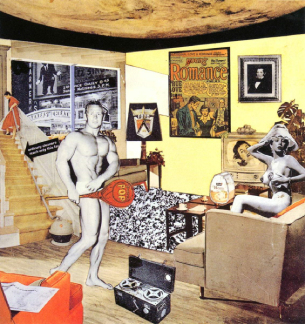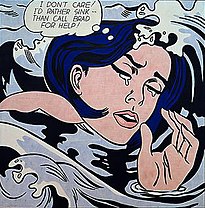Pop art is an art movement that emerged in the mid 1950s in Britain and in the late 1950s in the United States.[1] Pop art presented a challenge to traditions of fine art by including imagery from popular culture such as advertising, news, etc. In Pop art, material is sometimes visually removed from its known context, isolated, and/or combined with unrelated material.[1][2]The concept of pop art refers not as much to the art itself as to the attitudes that led to it.[2]
Pop art employs aspects of mass culture, such as advertising, comic books and mundane cultural objects. It is widely interpreted as a reaction to the then-dominant ideas of abstract expressionism, as well as an expansion upon them.[3] And due to its utilization of found objects and images it is similar to Dada. Pop art is aimed to employ images of popular as opposed to elitist culture in art, emphasizing the banal or kitschy elements of any given culture, most often through the use ofirony.[2] It is also associated with the artists' use of mechanical means of reproduction or rendering techniques.
Much of pop art is considered incongruent, as the conceptual practices that are often used make it difficult for some to readily comprehend. Pop art and minimalism are considered to be art movements that precede postmodern art, or are some of the earliest examples of Postmodern Art themselves.[4]
Pop art often takes as its imagery that which is currently in use in advertising.[5] Product labeling and logos figure prominently in the imagery chosen by pop artists, like in the Campbell's Soup Cans labels, by Andy Warhol. Even the labeling on the shipping carton containing retail items has been used as subject matter in pop art, for example in Warhol's Campbell's Tomato Juice Box 1964, (pictured below), or his Brillo Soap Box sculptures.


Origins
The origins of pop art in North America and Great Britain developed differently.[2] In the United States, it marked a return to hard-edged composition and representational art as a response by artists using impersonal, mundane reality, irony and parody to defuse the personal symbolism and "painterly looseness" of Abstract Expressionism.[3][6] By contrast, the origin in post-War Britain, while employing irony and parody, was more academic with a focus on the dynamic and paradoxical imagery of American popular culture as powerful, manipulative symbolic devices that were affecting whole patterns of life, while improving prosperity of a society.[6] Early pop art in Britain was a matter of ideas fueled by American popular culture viewed from afar, while the American artists were inspired by the experience of living within that culture.[3] Similarly, pop art was both an extension and a repudiation of Dadaism.[3] While pop art and Dadaism explored some of the same subjects, pop art replaced the destructive, satirical, and anarchic impulses of the Dada movement with detached affirmation of the artifacts of mass culture.[3] Among those artists seen by some as producing work leading up to Pop art are Pablo Picasso, Marcel Duchamp, Kurt Schwitters, and Man Ray.
United Kingdom: The Independent Group
The Independent Group (IG), founded in London in 1952, is regarded as the precursor to the pop art movement.[1][7] They were a gathering of young painters, sculptors, architects, writers and critics who were challenging prevailing modernist approaches to culture as well as traditional views of Fine Art. The group discussions centered on popular culture implications from such elements as mass advertising, movies, product design, comic strips, science fiction and technology. At the first Independent Group meeting in 1952, co-founding member, artist and sculptor Eduardo Paolozzi presented a lecture using a series of collages titled Bunk! that he had assembled during his time in Paris between 1947–1949.[1][7] This material consisted of "found objects" such as, advertising, comic book characters, magazine covers and various mass produced graphics that mostly represented American popular culture. One of the images in that presentation was Paolozzi's 1947 collage, I was a Rich Man's Plaything, which includes the first use of the word "pop″, appearing in a cloud of smoke emerging from a revolver.[1][8] Following Paolozzi's seminal presentation in 1952, the IG focused primarily on the imagery of American popular culture, particularly mass advertising.[6]
Subsequent coinage of the complete term "pop art" was made by John McHale for the ensuing movement in 1954. "Pop art" as a moniker was then used in discussons by IG members in the Second Session of the IG in 1955, and the specific term "pop art" first appeared in published print in an article by IG members Alison and Peter Smithson in Arc, 1956.[9] However, the term is often credited to British art critic/curator, Lawrence Alloway in a 1958 essay titled The Arts and the Mass Media, although the term he uses is "popular mass culture".[10] Nevertheless, Alloway was one of the leading critics to defend the inclusion of the imagery found in mass culture in fine arts.

United StatesAlthough Pop Art began in the late 1950s, Pop Art in America was given its greatest impetus during the 1960s. By this time, American advertising had adopted many elements and inflections of modern art and functioned at a very sophisticated level. Consequently, American artists had to search deeper for dramatic styles that would distance art from the well-designed and clever commercial materials.[6] As the British viewed American popular culture imagery from a somewhat removed perspective, their views were often instilled with romantic, sentimental and humorous overtones. By contrast, American artists being bombarded daily with the diversity of mass produced imagery, produced work that was generally more bold and aggressive.[7]
Two important painters in the establishment of America's pop art vocabulary were Jasper Johns and Robert Rauschenberg.[7] While the paintings of Rauschenberg have relationships to the earlier work of Kurt Schwitters and other Dadaists, his concern was with social issues of the moment. His approach was to create art out of ephemeral materials and using topical events in the life of everyday America gave his work a unique quality.[7][11] Johns' and Rauschenberg's work of the 1950s is classified as Neo-Dada, and is visually distinct from the classic American Pop Art which began in the early 1960s.[12][13]
Of equal importance to American pop art is Roy Lichtenstein. His work probably defines the basic premise of pop art better than any other through parody.[7] Selecting the old-fashioned comic strip as subject matter, Lichtenstein produces a hard-edged, precise composition that documents while it parodies in a soft manner.
The paintings of Lichtenstein, like those of Andy Warhol, Tom Wesselmann and others, share a direct attachment to the commonplace image of American popular culture, but also treat the subject in an impersonal manner clearly illustrating the idealization of mass production.[7] Andy Warhol is probably the most famous figure in Pop Art. Warhol attempted to take Pop beyond an artistic style to a life style, and his work often displays a lack of human affectation that dispenses with the irony and parody of many of his peers.

Early exhibitionsClaes Oldenburg, Jim Dine and Tom Wesselmann had their first shows in the Judson Gallery in 1959/60. In 1960 Martha Jackson showed installations and assemblages, New Media - New Forms featured Hans Arp, Kurt Schwitters, Jasper Johns, Claes Oldenburg, Robert Rauschenberg, Jim Dine and May Wilson. In 1961, Oldenburg created a store for Martha Jackson's spring show Environments, Situations, Spaces. In December he showed The Store at his studio.[16][17]
In London, the annual RBA exhibition of young talent in 1960 first showed American Pop influences. In January 1961, the most famous RBA-Young Contemporaries of all put David Hockney, the American R B Kitaj, Allen Jones, Derek Boshier, Patrick Caulfield, Peter Phillips and Peter Blake on the map. Hockney, Kitaj and Blake went on to win prizes at the John-Moores-Exhibition in Liverpool in the same year.
Opening October 31, 1962, Willem de Kooning's New York art dealer, the Sidney Janis Gallery, organized the groundbreaking International Exhibition of the New Realists, a survey of new to the scene American Pop, French, Swiss, Italian New Realism, and British Pop art. The fifty-four artists shown included Richard Lindner, Wayne Thiebaud, Roy Lichtenstein, Andy Warhol, Claes Oldenburg, James Rosenquist, Jim Dine, Robert Indiana, Tom Wesselmann, George Segal, Peter Phillips and Peter Blake (his large The Love Wall from 1961) and Yves Klein, Arman, Daniel Spoerri, Christo, Mimmo Rotella. Martial Raysse, Niki de Saint-Phalle and Jean Tinguely saw the show in New York and were stunned by the size and the look of the American work. Also shown were Marisol, Mario Schifano, Enrico Baj and Öyvind Fahlström. Janis lost some of his abstract expressionist artists, as Mark Rothko, Robert Motherwell, Adolph Gottlieb and Philip Guston quit the gallery but gained Dine, Oldenburg, Segal and Wesselmann.[18]
A bit earlier, on the West-coast, Roy Lichtenstein, Jim Dine and Andy Warhol from NYC, Phillip Hefferton and Robert Dowd from Detroit; Edward Ruscha and Joe Goode from Oklahoma City, and Wayne Thiebaud from California were included in the New Painting of Common Objects show. This first Pop Art museum exhibition in America was curated byWalter Hopps at the Pasadena Art Museum [1]. Pop Art now was a success and was going to change the art world forever. New York followed Pasadena in 1963 when theGuggenheim Museum exhibited Six Painters and the Object, curated by Lawrence Alloway. The artists were Jim Dine, Jasper Johns, Roy Lichtenstein, Robert Rauschenberg, James Rosenquist, and Andy Warhol.[19]
By 1962, the Pop artists began to exhibit in commercial galleries in New York and Los Angeles, for some it was their first commercial one-man show. The Ferus Gallery presented Andy Warhol in Los Angeles and Ed Ruscha in 1963. In New York, the Green Gallery showed Rosenquist, Segal, Oldenburg, and Wesselmann, the Stable Gallery R. Indiana and Warhol (his first New York show), the Leo Castelli Gallery presented Rauschenberg, Johns, and Lichtenstein, Martha Jackson showed Jim Dine, and Allen Stone showed Wayne Thiebaud. By 1965–1966 after the Green Gallery and the Ferus Gallery closed the Leo Castelli Gallery represented Rosenquist, Warhol, Rauschenberg, Johns, Lichtenstein and Ruscha, The Sidney Janis Gallery represented Oldenburg, Segal, Wesselmann and Marisol, while Allen Stone continued to represent Thiebaud, and Martha Jackson continued representing Robert Indiana.








Hiç yorum yok:
Yorum Gönder